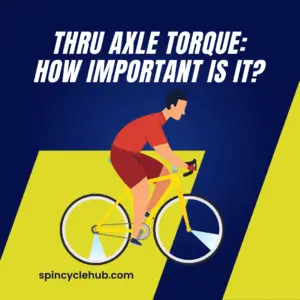Introduction
When it comes to cycling, there are many components that contribute to a smooth and safe ride. One such component is the thru axle, a specialized type of axle commonly found on modern bicycles. While cyclists often focus on aspects like tire pressure, gear ratio, and suspension setup, it’s easy to overlook the importance of proper thru axle torque. In this article, we’ll delve into the significance of thru axle torque, why it matters, and how it can impact your overall riding experience.
Understanding Thru Axles
Before we dive into the torque aspect, let’s quickly discuss what thru axles are. Thru axles are a type of axle system that secure the wheel to the frame of the bicycle. They differ from traditional quick-release axles in that they provide increased stiffness and stability, enhancing the overall performance and safety of the bike.

The Role of Torque in Thru Axles
What is Torque?
Torque is essentially the force required to rotate an object around a fixed axis. In the context of thru axles, torque refers to the tightness or tension applied when securing the axle to the frame. It ensures that the thru axle is properly engaged and prevents any unwanted movement or play.
Importance of Proper Torque
Maintaining Wheel Alignment and Stability Proper torque plays a vital role in maintaining wheel alignment and stability. When a thru axle is too loose, it can cause the wheel to move within the fork or dropout, leading to misalignment. This can result in poor handling, reduced control, and even accidents. On the other hand, if the thru axle is overtightened, it can damage the frame or the axle itself, compromising the integrity of the entire system.
Preventing Unwanted Movement and Play
In addition to alignment, proper torque prevents unwanted movement and play in the thru axle. A loose axle can allow the wheel to wobble or shift during rides, causing discomfort and affecting the bike’s performance. This can be especially problematic when traversing rough terrain or engaging in high-speed descents. By applying the correct torque, you ensure that the thru axle remains securely in place, reducing the risk of any unexpected wheel movements.
Impact on Handling and Control of the Bike
The torque applied to the thru axle directly affects the bike’s handling and control. If the axle is not tightened properly, you may experience a vague or mushy feeling when steering or cornering. This lack of precision can be disconcerting, making it harder to navigate obstacles and increasing the chances of losing control. On the other hand, an axle that is overtightened can create excessive stiffness, resulting in a harsh and uncomfortable ride. Finding the right balance of torque is essential for optimal handling and control.
Factors to Consider for Thru Axle Torque
To achieve the appropriate torque for your thru axle, there are several factors to consider: Manufacturer’s Recommendations
It’s crucial to consult the manufacturer’s recommendations for your specific bike model and thru axle. They often provide torque specifications that are tailored to their components, taking into account the materials used and the intended usage of the bike.
Material and Design of the Thru Axle
Thru axles come in various materials, such as aluminum, steel, and titanium. Each material may have different torque requirements due to variations in strength and tolerance. Additionally, the design of the thru axle, including its length and thread pitch, can affect the optimal torque value.
Frame and Fork Specifications
The frame and fork of your bicycle also play a role in determining the appropriate torque for the thru axle. Different frame materials, such as carbon or aluminum, may require specific torque settings to avoid damage. Similarly, fork designs can influence the torque requirements, so it’s essential to consider these factors when adjusting the thru axle.
Rider Preferences and Riding Conditions
Lastly, rider preferences and riding conditions can impact the desired torque setting. Some riders may prefer a slightly looser or tighter thru axle based on their riding style or personal comfort. Additionally, the type of terrain you ride on, whether it’s smooth pavement or rugged trails, may influence the torque needed to maintain stability.
Torque Specifications and Tools
To achieve accurate and consistent torque values, it’s recommended to use a torque wrench specifically designed for thru axles. These wrenches allow you to set and measure the torque applied with precision. Consult the manufacturer’s specifications and adjust the torque wrench accordingly. Remember to follow the appropriate tightening sequence, typically tightening each side evenly to ensure balanced torque distribution.
Overcoming Common Challenges
Achieving the proper torque for thru axles can sometimes present challenges. Stripped threads or damaged axles can make it difficult to maintain the desired torque value. In such cases, it’s essential to address the issue promptly by replacing damaged components or seeking professional assistance. Regular maintenance and inspection can help identify potential problems before they become more severe.
Consequences of Improper Torque
The consequences of improper thru axle torque can be significant. Insufficient torque can lead to wheel misalignment, compromised stability, and poor handling, putting your safety at risk. Overtightening can result in damaged components, including the frame or the axle itself. It’s crucial to recognize the importance of proper torque application to avoid accidents, injuries, and costly repairs.
Best Practices for Thru Axle Torque
To ensure optimal performance and safety, here are some best practices to follow:
– Follow the manufacturer’s guidelines and torque specifications for your bike and thru axle.
– Use a torque wrench to apply the correct torque with precision.
– Regularly check and adjust the thru axle torque, especially after transporting your bike or performing maintenance.
– Seek professional assistance if you encounter difficulties or suspect any issues with your thru axle.
– Develop a sense of feel over time by paying attention to any changes in handling or wheel alignment during rides.
Conclusion
Proper thru axle torque is a crucial aspect of bike maintenance that should not be overlooked. It directly affects wheel alignment, stability, handling, and control. By following the manufacturer’s recommendations, using the right tools, and regularly checking the torque, you can ensure a safe and enjoyable cycling experience. Remember, finding the perfect balance between too loose and too tight is key to optimizing your bike’s performance.

FAQs
- How often should I check the torque of my thru axle?It is recommended to check the torque of your thru axle periodically, especially after transporting your bike or performing maintenance. As a general guideline, checking it every few weeks or before important rides is a good practice.
- Can I use a regular wrench instead of a torque wrench for thru axles?While using a torque wrench is highly recommended for precise torque application, if you don’t have access to one, you can use a regular wrench with caution. Be mindful of the amount of force you apply and aim for a consistent tightness. However, keep in mind that without a torque wrench, it can be challenging to achieve the exact torque value specified by the manufacturer.
- What are the signs of an overtightened or loose thru axle?An overtightened thru axle may result in difficulty in turning or removing it. You may also experience a harsh ride due to excessive stiffness. On the other hand, a loose thru axle can cause noticeable wheel wobble, unusual handling, or even a rattling noise. If you observe any of these signs, it’s important to check the torque and adjust it accordingly.
- Is it possible to damage my frame by applying incorrect torque?Yes, applying incorrect torque to your thru axle can potentially damage the frame. Overtightening can cause stress or cracks in the frame material, particularly if it’s made of carbon. It’s crucial to follow the manufacturer’s recommended torque specifications to avoid any frame-related issues.
- Are there any specific maintenance tips for thru axles?Regularly inspect your thru axle for signs of wear or damage. Clean and lubricate it as needed, following the manufacturer’s guidelines. Additionally, periodically check the torque and ensure it remains within the specified range. If you encounter any issues or concerns, consult a professional bike mechanic for assistance.
- How to Properly Tighten a Thru Axle This article from www.thruaxle.com offers a step-by-step guide on properly tightening a thru axle, including the use of a torque wrench and common mistakes to avoid.
- Thru Axle Compatibility hexlox.com provides comprehensive information on thru axle compatibility, torque specifications, and maintenance tips. The article covers various types of thru axles and offers insights on choosing the right one for your bike.
Watch this one,
Video Credits – BikeRumor
DOWNLOAD THIS ARTICLE :Click Here
You May Also Like



